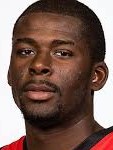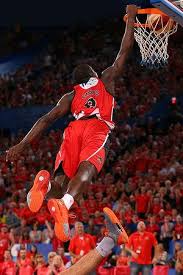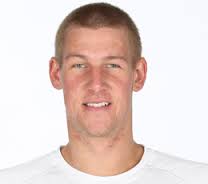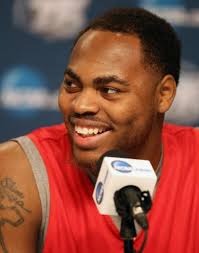 NBA teams have been drafting European players and stashing them overseas for several years. But the term “Eurostash” has taken on a whole new meaning this season.
NBA teams have been drafting European players and stashing them overseas for several years. But the term “Eurostash” has taken on a whole new meaning this season.
It’s the Americans who are being stashed across the pond, too. And one of them can actually be called an “Aussiestash.” There’s a new term for y’all.
This year’s draft featured five American players taken out of college who are currently hooping overseas while their rights are retained by NBA teams.
And that doesn’t count second-round picks Pierre Jackson (Pelicans, No. 42, Baylor) and Alex Oriakhi (Suns, No. 57, Missouri), who have been cut by their foreign teams.
Since second-round picks usually are not guaranteed to make NBA rosters, teams can use Europe (or Australia, Asia and South America) as a viable option to develop their draft picks on someone else’s dime while still retaining the rights to the player down the road.
Typically, European players took this route to continue their development on their home continent, delaying their arrival stateside until they expanded their skills or had a more relaxed escape clause in their contract.
However, the D-League ‘s spartan rookie pay scale has made playing overseas a viable option even for American rookies, who despite being drafted may not want to risk getting cut in training camp and being forced to play for pennies in the minors.
With the first stage of the major European cups coming to a close, here is a look at the five American 2013 draft picks playing overseas.

 44. Mike Muscala, PF, Atlanta
44. Mike Muscala, PF, Atlanta
Playing for Obradorio of the Spanish ACB, the top domestic league in Europe, the big man out of Bucknell has been effective and consistent in a league that is very difficult to succeed in as a rookie. Despite the physical play of the ACB, Muscala leads the league in rebounding with 8.6 in 25.3 minutes per game.
Despite Muscala’s apparent lack of strength, he is always playing for contact. Adding strength is something most bigs can do as pros, but determination, spirit and toughness is something naturally ingrained, and Muscala has a rock-solid mentality that should serve him well throughout his career. What he lacks in strength he makes up for with excellent lateral quickness, proving to be more than capable of defending quicker players on switches in the pick-and-roll.
With Atlanta signing Paul Millsap for only two years, it may not be a long wait for minutes to open up in the frontcourt. While Muscala likely does not have the ceiling to be a starting NBA big, he should prove more than capable in a role of 15 to 25 minute off the bench when he returns from his European adventure.

![Denver_Nuggets_logosheet[08-09]](http://sheridanhoops.com/wp-content/uploads/2012/04/Nuggets1.jpg) 46. Erick Green, G, Denver
46. Erick Green, G, Denver
Green parlayed a 25-point scoring average as a senior at Virginia Tech into becoming the 46th pick in the draft before opting to spend his rookie season abroad with Montepaschi Siena, the defending champions of the Italian league. While Green may have been the ACC Player of the Year, he has made the necessary adjustment to his role on a deep Siena team that just missed qualifying for the Top 16 stage of the Euroleague.
While not the greatest athlete, Green is a very efficient guard who produces consistently. What he lacks is the ability to create looks for himself off the dribble and get to the line. Currently, he makes his living off his smooth pull-up jumper and capitalizing on defensive mistakes. But the NBA often requires guards to perform in isolation and one-on-one situations, areas where Green needs to improve.
With Daniel Hackett heading to Milano, Green possibly will be playing in a more featured role, giving him valuable reps down the stretch of the Italian season and in the second stage of the Eurocup. With the ball in his hands a bit more, Green should have the opportunity to expand his game and could get an opportunity to latch on with Denver this summer.

 50. James Ennis, SF, Miami
50. James Ennis, SF, Miami
A 6-7 small forward out of Long Beach State, Ennis is a lights-out shooter who has taken his talents far away from South Beach en route to the NBA. After being selected by Miami in the second round, Ennis signed with the Perth Wildcats in Australia, as it became apparent that making the Heat’s roster was far from a sure thing.
 The second-leading scorer in Australia at 22.4 points, Ennis is shooting a blistering 43.5 percent from the arc on more than five attempts per game.
The second-leading scorer in Australia at 22.4 points, Ennis is shooting a blistering 43.5 percent from the arc on more than five attempts per game.
While the Australian league is not as strong as the top European leagues, Ennis has been given plenty of opportunity to expand his game and prove he is more than just a shooter.
While his outside shot will surely be his calling card at the highest level, he is proving that he is no slouch with the ball in his hands and a solid enough rebounder and defender to allow coaches to feel comfortable with him on the floor.
With the careers of Shane Battier and James Jones coming to a close, Ennis could emerge from Down Under to replace some of the valuable 3-pointers Miami’s wings have provided through the last three playoff runs. In what was a weak draft, coming away with a quality shooter such Ennis will look like a very solid grab down the road.

 53. Colton Iverson, C, Boston
53. Colton Iverson, C, Boston
A 7 foot center from Colorado State, Iverson ironically is playing for Besiktas, the same Turkish squad that Allen Iverson suited up for when he defected to Europe. As a true center, Iverson is a very intriguing asset for Boston, as the global market for true pivots has been dwindling.
Iverson has been efficient, shooting 55 percent from the field while averaging 6.5 rebounds in just under 23 minutes this season. A late bloomer, Iverson has been building on the big improvement he made in his senior season, showing that he has potential to be an effective finisher and rebounder coming off an NBA bench.
While Iverson may not be much of a shot-blocker and possesses below-average lateral quickness, true centers who finish at a high rate and have strong rebounding efficiency numbers are a valuable commodity worldwide.
With a bit more experience, Iverson could eventually be a valuable contributor for the Celtics.

 58. Deshaun Thomas, F, San Antonio
58. Deshaun Thomas, F, San Antonio
A perimeter shooting forward out of Ohio State, the Spurs sent Thomas to Europe to get some seasoning with Nanterre, which last season went on a miraculous run as an eighth seed to win the French League title and qualify for the Euroleague.
Thomas has been holding his own, shooting 36 percent from behind the arc. The issue with Thomas is that he is an NBA tweener – undersized to play power forward and not quick enough to consistently defend at small forward.
As a forward with a good outside shot, Thomas certainly is fit for the European style. But to play in the NBA, he will need to make a big improvement with his defensive IQ to compensate for his lack of foot speed and length. Since his game translates well in Europe, he likely will have the opportunity to play for some of the top clubs in Europe to take his game to the next level.
AJ Mitnick is an American living in Israel and working for Maccabi Rishon Lezion of the Israeli Basketball Super League. A graduate of IDC Herzliya, Mitnick also blogs at mindlessdribble.net and is pursuing a pro basketball coaching license from the Wingate Institute in Israel. Follow him on Twitter.